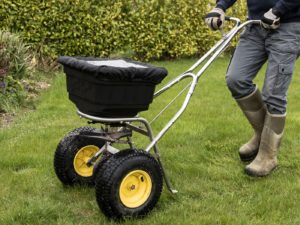Time Between Weed and Feed and Seed

Liquid Broadleaf Weed Control – September is the best time of the year to control perennial weeds that live from year to year (dandelion, clover, plantain, etc.) so they're not in the lawn next spring. If you have a lawn full of weeds, this is the first thing to do before doing any overseeding this fall. We have several different selective, liquid weed controls in ready-to-use and concentrate that you mix with water to apply to the weeds. To cover the whole lawn (blanket spray), use a hose-end sprayer, pump sprayer or rent one of our Lawn Depot liquid spreaders. If you have been keeping up with the weeds and the lawn doesn't warrant whole lawn application, walk the whole lawn and spot treat any weedy areas as you go. Remember to withhold overseeding treated areas for 2-3 weeks and do not apply if rain is in the forecast or the air temperature is over 85 degrees. Once the spray has dried, wait at least 24 hours before mowing the lawn.
Fertilization in September – Cool-season grasses (fescues, ryegrasses and bluegrasses) grow best in the cooler seasons. The stresses our lawns endure all summer finally break once the cooler temperatures of fall arrive. To help aid in the recovery and to feed actively growing roots, fertilize with our organic-based, slow-release fertilizer now. It will release nutrients over 8 weeks to feed the lawn throughout the fall, while also adding organic compost to the soil. Follow up this September feeding with our WINTERFEAST fertilizer in November for a healthy, green lawn next spring.
Seeding in September and October – Most of us will need to do at least some seeding this fall due to damage caused by the hot, dry summer. It is now time to repair the damage. It is also now the time for upgrading entire lawns that have become weak or uncared for. Fall is by far the best (really the only) time of the year for seeding lawns. The ground is warm and as we get deeper into the fall, the nighttime temperatures will be perfect for all grass, from seeds to existing lawns. Roots grow well and deeper in warm soils, while the cool night air along with anticipated regular rainfall is perfect for germinating seeds. When seeding, if we don't get enough regular rainfall, supplemental watering will help speed along the seed germination and establishment. And as the newly seeded areas germinate and begin to establish, carefully and regularly mow the new lawn as you do your other grass, being absolutely careful to cut the new grass only when it is dry, or you'll tear it.
Checking for Grub Damage in Lawns – Another problem stemming from the extended dry weather over the past several weeks is the fact that it has made potential grub damage in lawns difficult to identify. Rest assured, grubs do not die in dry conditions; their egg hatch is simply delayed. If you had lots of Japanese beetles in July, particularly if you did not apply MERIT/MALLET preventative grub control in May/June, we urge you to be vigilant when the rains come and the lawns resume growth. Areas that don't green up; areas that peel back when scratched with a rake; areas where flocks of black birds are feeding in your lawn areas; all these are signs of potential turf damage from grubs. If you find the half-inch long off-white worms when you scratch the brown areas, you must immediately treat the lawn or at least large areas of the lawn around where you've found the grubs with DYLOX granular insecticide and water it in thoroughly. You'll probably need to do some seeding in these areas too, so be prepared. If you ignore the need to repair the lawn this fall, you may have a mess next spring that will be MUCH harder to correct. If you have questions, come in to the store and discuss them with one of our staff. We've been here many times before and will guide you.
Soil Conditioning in September – We recommend that all lawns be limed and core aerated every year in order to help stimulate deeper and denser root systems. Liming can be done at any time of the year (other than when snow's flying) with PRO-CAL fast acting lime. It's applied in an easy to handle, pelletized form, which will raise soil pH in weeks instead of months! As mentioned above, core aeration (the pulling of soil cores from the lawn) helps break up the heavy, dense soil so root systems get bigger and reach deeper into the soil. Core aeration is also the best way to prepare for fall seeding. By opening up the soil with thousands of pockets for seed and water to collect in, it's the most effective way to produce a thicker, healthier lawn next spring.
Source: https://lawndepotinc.com/september-is-the-perfect-time-to-weed-feed-seed-your-lawn/?utm_source=rss&utm_medium=rss&utm_campaign=september-is-the-perfect-time-to-weed-feed-seed-your-lawn
0 Response to "Time Between Weed and Feed and Seed"
Postar um comentário